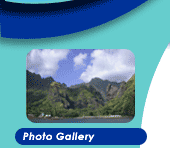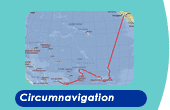June 30, 2001
Taveuni Island, Fiji
Taveuni Bound
By Lois Joy  
The bus groans up the hills along the Sunshine Highway, burdened with
its heavy load, as we leave Savusavu behind. It is jam packed with Fijians,
Indians, luggage and food. The stench of human sweat rolls back to us.
We are crammed into the ‘aisle seats’ of the uncomfortable
metal benches, stuffed three abreast. I hold on to the handlebars in
front of me to steady the jerking and swaying motion while I protecting
the daypack containing my camera by hugging it between my legs on the
floor. There are no luggage racks on this bus and no under-bus storage
either, even though it is the only commuter bus that meets the ferry
bound for Taveuni. Since the seats are filled, luggage fills the aisles.
The aisle to my left is piled four duffels high; they make a convenient
arm rest.
Finally, the bus gasps at the top of the hills, then continues on in
an easier mode. The passengers open the windows to catch the welcome
breeze from the sea. They begin to relax, talk, and eat. I strike up
a conversation with the two Indian boys sitting next to me. The little
boy next to the window is munching the last few peanuts from a square
woven basket on his lap that is almost as big as he is. His name is
Jes. I recognize him as the peanut vendor to whom Gunter had given a
50-cent Fijian coin for a few peanuts, carefully wrapped in a square
of cellophane and stapled. We had been his first customer, having arrived
early for the bus at 0730. Jes is little and thin, with jet black, closely
cropped hair, in a colorful bula shirt and long pants. A budding entrepreneur.
Merely getting on to this crowded bus has been an adventure in itself.
The bus was not due to arrive until 0830, so we were at the bus station
in plenty of time. We watched the buses arrive, fill up, and depart
but none of them said “Taveuni.” Gunter checked with the
ticket master. “It is sometimes late,” he said. I smiled
and said, “Fiji Time,” and took a few photos. The epitome
of a Fijian Grandfather sat across from me under the tin-covered waiting
area. He wore a flowered blue bula shirt, a red warrior-print sulu with
‘SAVU SAVU’ in white block letters. He had frizzy gray hair,
and carried a walking stick as gnarled as his bare toes that pointed
every which way.
Meanwhile, Gunter had been pacing around—a good thing—because
he found that our bus was parked —not at the station—but
out on the main street, and people were lining up to board. “One
hour early and we are late getting on,” he panted as we ran for
it with our luggage. We entered the bus to find every seat marked with
backpacks or duffels. We stood in the aisle for awhile, then sat down
in unoccupied seats, hoping that they weren’t ‘saved.’
More and more bodies piled on: children with dripping candy and ice
cream cones; mothers with pillows and babies and diaper bags; burly
boys and men hefting huge duffels, rolled up mats, and even packages
of yaquona (for making kava). Luggage filled the aisles, and those who
came later to ‘reserved’ seats near the back of the bus
merely climbed over the seats to their places.
I hoped that whoever had left the small backpack on the seat I was
now occupying would be small to match the size of the pack. A young
boy came and sat down next to me. “Ah,” I thought. “I’m
lucky.” But then wooly-haired Fijian mother with the widest hips
I had ever seen appeared at my seat—holding a child, a huge satchel
and a blanket! That’s how I ended up with the aisle seat further
back with the boys. I had climbed over the seats with my daypack and
our snorkeling bag. Gunter still stood in the aisle, fuming. His seat
had also been taken. He had gone forward to talk to the driver. “I
have a ticket but no seat,” he had grumbled.
“If you want a seat, come back on Wednesday,” the bus driver
had answered curtly.
“Just sit down where you are,” I said. Fortunately, there
were only two passengers in that seat. They scrunched over toward the
window without a word. Gunter piled the rest of our luggage in the aisle.
As the bus clanked along on the ‘Sunshine Highway,’ the
mothers began to nurse their babies and the wind continued to blow through
the bus from the sea. Gunter cooled off. He turned back to me with a
smile, “The beginning of our Taveuni adventure,” he mouthed.
We bumped along though tin-house villages, jungle growth, and copra
plantations on a washboard road that shook every joint of my body. With
all this shaking going on, many of the passengers were actually going
to sleep! Jes, the peanut vendor, slumped over the gigantic handle of
his basket. The hefty lady in front of Gunter positioned her pillow
against the jumping metal seat in front of her and dozed off. Others
with no pillows merely collapsed forward onto themselves, their heads
almost resting on their stomachs.
After two long hours, the bus finally rounded a teal, picturesque bay
and stopped at the Ferry Landing. Families spread out the blankets they
brought and sat down to wait. A vendor sold cold water and juice out
of a cooler. Lines formed for the two bathrooms—with toilet seats
slung into a corner, dirty rims, and no hooks— workable if one
hangs everything around one’s neck and doesn’t touch a thing.
Then the ferry could be seen around the bend and chaos ensued. The
teenagers rushed first onto the dock, followed by the burdened-down
families. Gunter went into frenzy. “Rush to the front,”
he urged. As I walked forward to the narrow part of the landing, a young
Fijian man sporting a blue woolen cap rushed by, his huge duffel swinging
into me. I almost lost my balance. “Go,” Gunter urged. As
the ferry docked, I had managed to sneak through to the front, and ended
up behind a mammoth Fijian woman seeing off her young son. After he
embarked, she just stood there. “Push,” mouthed Gunter.
Instead, I managed to duck underneath her massive arms and was soon
inside the ferry. As vertically challenged as I am, I still had to duck
to enter the low-roofed passenger compartment. I saved a spot on the
bench for Gunter, who followed with our luggage. The benches were soon
filled. Families calmly spread out their blankets on the floor. After
every surface was filled, the ferry left the dock.
I looked around for life preservers. I didn’t see a one. I figured
the ferry was ‘double-booked’ at the minimum, since the
ones who did not have seats were about equal to those who did. Fortunately,
the waves were not high until we turned into them as we approached Taveuni.
Then they sprayed into the open ‘windows’ of the ferry and
the occupants of the benches next to them had to pull down the tarp.
From then on, the ride became very claustrophobic because there was
little light and one could not see the horizon. I would not want to
take this voyage during a period of high winds. A storm under these
conditions could be catastrophic. After disembarking, I took a photo
of the ‘life raft.’ It consisted of two flat sections of
boards nailed together!
“Been there, done that,” I sighed as we negotiated for
a ride to Susie’s Plantation where we would stay in a bure on
‘Fiji’s Garden Island’ for one week. Needless to say,
we took a different, much larger ferry back straight to Savusavu that
also eliminated the bus ride. It meant that we had to cut our stay short,
since it only came twice a week. But that was fine with us.
Go
to photogallery...
journal105.html
|











